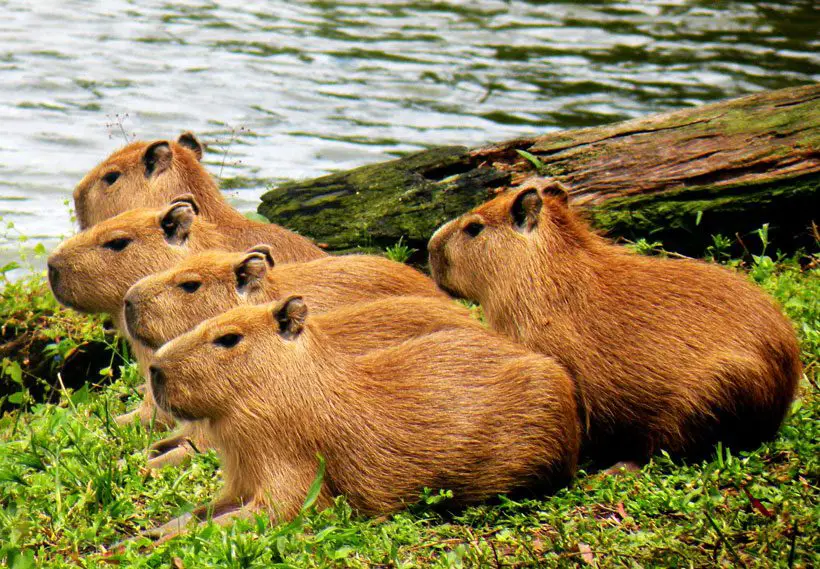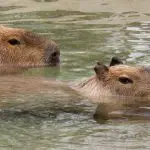Capybara Habitat: Where Do These Giant Rodents Live?
Capybaras are one of the rare species of rodents since they are found in most isolated regions in South America. To locate these animals, you need to understand their preferred habitats and the ecosystem around them.
So, where do these giant rodents live? Capybaras prefer living in densely forested rainforests that are near water bodies. They also live in swamps and ponds with water hyacinths. However, they can live indoors equipped with accessories necessary for their survival.
This article reviews the natural habitats of these giant rodents and the features that support their existence in those different habitats. In addition, we shall also discuss their geographical distribution.
Capybara Habitat: Where Do These Giant Rodents Live?
Do you have a hard time locating these giant rodents? Worry not. Following are their preferred habitats with geographical distribution discussed.

Habitat Preference
Capybaras’ suitable habitat is found in thick rainforests with a dense vegetation cover necessary for food supply. These habitats are close to water bodies such as ponds and lakes since they are semi-aquatic animals.
These giant rodents prefer living in places with thick vegetation cover that will hide them from enemies and the scorching sun in the fields. In South and Central America, they are found in rainforests close to water bodies.
Capybaras are also found in seasonally flooded grasslands and savannahs. They, however, vacate and search for other habitats with swamps of water bodies near them once the flooded areas dry.
Geographical Distribution Of Capybaras
With the increasing domestication of these rodents in the USA, you can easily spot one in captivity or their wild natural habitats. However, capybaras are geographically distributed in America’s South and Central regions.
You can also locate them in the Pantanal of Brazil, with enough vegetation cover and water to swim and rest. According to landscape-analysis patterns of habitat use and selection by the capybara, their distribution is affected by presence of water bodies and the existing climate conditions.

Capybaras can also be spotted in seasonally flooded regions of the Llanos in Colombia and Venezuela. They were first seen in Florida in the early 1990s, where they escaped captivity and bred to occupy these regions.
Though in small numbers, capybaras are also found in Argentina, Uruguay, and Peru. Their geographical distribution is affected by security, food, and water availability.
Factors Affecting The Distribution Of Capybaras

The following aspects govern their distribution in habitats-
Food Availability
Capybaras are herbivores – meaning they feed on grass, tree barks, and green pastures in the rainforest. Therefore, it is likely to find these rodents in places with sufficient grazing land and ample vegetation cover.
The Southern and Central America’s rainforests provide the best vegetation cover for capybaras to feed on. Water ponds and swamps provide water hyacinths that offer food for capybaras when in water.
Security From Predators
Capybaras are the prey of most cat family animals and snakes, such as green anacondas, for their protein-rich meat. These threats keep capybaras off since they are not adapted to fight predators.
Capybaras prefer thick forests with bushes to hide from enemies. They also like shallow water bodies that are easy to escape from predators such as the anaconda.
Close Proximity To Water Bodies
Capybaras are semi-aquatic animals; hence they spend most of their time in the water swimming or immersed during the hot climate. They prefer living in geographical areas with secure water bodies to help cool their bodies and swim.
Common Features Found In Capybaras Habitats
Capybaras will not just occupy any ecosystem in a forest. They tend to spy on the land and assess the region’s conditions before settling and reproducing.

Guided by the earlier discussed factors that affect their distribution, their habitats are characterized by the following features.
- Thick vegetative cover with bushes and shrubs to feed on
- Water bodies such as lakes, ponds, river streams, marshes, and seasonally flooded grasslands
- Vast and open grasslands with an unobstructed view of any incoming danger from predators
When in captivity, you need to provide the following features.
- Water ponds deep enough for capybaras to swim
- A fence around their grazing unit to avoid trespasses
- Toys in the cages for capybaras
- Feeding troughs for supplement feeds
Watch this video on standard enclosure for capybaras.
FAQs
Below are frequently asked questions concerning capybara habitat.
Q: How Are Capybaras Adapted To Their Natural Habitat?
Capybaras are physically adapted to a semi-aquatic lifestyle. Their webbed feet help them wade through and swim in water bodies when escaping from enemies or cooling their bodies.
They can also easily manoeuvre in muddy and soft grounds, especially in marshy and seasonally flooded habitats.
Q: Which Is The Main Threat To These Giant Rodents In Their Habitats?
Capybaras face a major threat from jaguars which occupy the same ecosystem with capybaras. Humans have also become a common threat to capybaras due to the increased demand for their meat and skin.
In the aquatic ecosystem, capybaras are predated by the green anaconda and alligators that live in water bodies.
Q: For How Long Can Capybaras Stay In Aquatic Habitats?
In water, capybaras can stay afloat in water for hours with the nose protruding above the water’s surface. They also stay for up to five minutes immersed in water when resting and escaping from predators.
During hot climates, capybaras swim in water bodies for up to six hours while feeding on water hyacinths.
Conclusion
Capybaras are mostly found in thick rainforests with lots of vegetation cover that provides enough food for these giant rodents. Their habitats must be close to water bodies since they are semi-aquatic.
They also prefer seasonally flooded grasslands to serve as grazing points with water to cool their bodies. Capybaras are naturally found in Central and South America regions such as Peru, Venezuela, Florida, Colombia, and most regions with cool temperatures and enough grazing fields.




